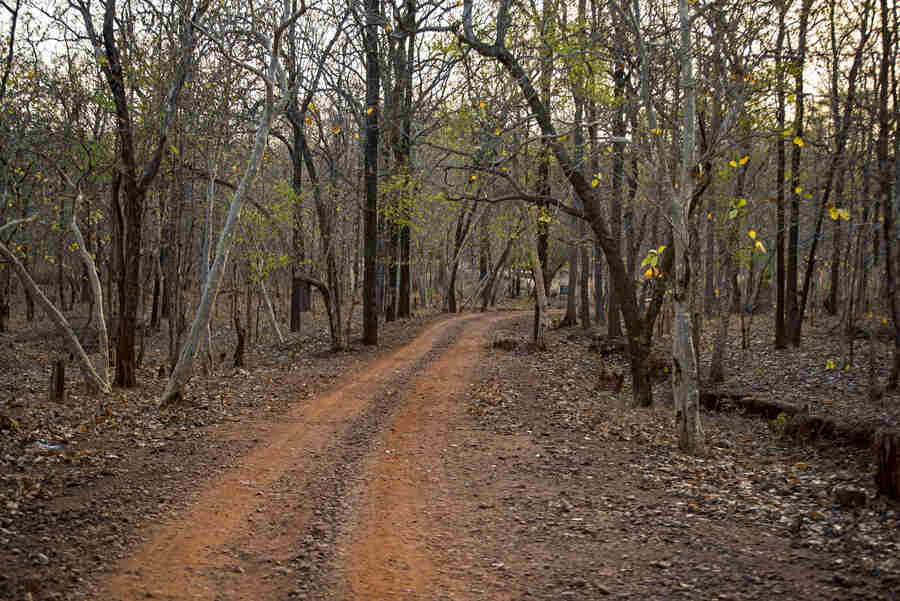The environment ministry's advisory committee has recommended 'in-principle' approval to a Telangana government proposal for de-notification of 1,501.88 hectares of reserve forest land to relocate five villages from the core area of the Amrabad Tiger Reserve in Nagarkurnool district.
The state government has said the relocation is voluntary and aims to consolidate wildlife habitat, reduce human-wildlife conflict and improve ecosystem protection. A total of 1,54,977 trees of 27 species will be felled for the exercise, according to the proposal.
According to the agenda note considered by the committee in its meeting on July 30, the proposal sought diversion of forest land in compartments 465, 466, 467, 468, 469, 470, 471, 472 and 473 of the Bacharam Reserved Forest of Achampet Division for relocation of Kollampenta, Thatigundal Penta, Sarlapally, Kudichinthala Bailu and Vatvarlapally villages from the core area of the reserve.
The proposal involves relocation in two phases. In phase I, 417 families from Sarlapally (Phase-I), Kudichinthala Bailu, Kollampenta and Thatigundal Penta will be shifted, requiring 546 hectares. At Rs 15 lakh per family, the budget for phase I is Rs 62.55 crore, according to the DFO Nagarkurnool.
In phase II, 836 families from Vatvarlapally and Sarlapally (Phase-II) will be relocated, requiring 955.88 hectares. The budget for phase II is Rs 125.4 crore.
The DFO informed that approvals from gram sabhas, the district level committee, the state level committee and the National Tiger Conservation Authority (NTCA) have been obtained.
The five villages are located in the core area of the reserve notified under Section 38(v) of the Wildlife (Protection) Act, 1972, and need to be relocated to make the core inviolate.
A tiger reserve consists of two zones: the core (critical tiger habitat) and the buffer (peripheral area).
According to the Wildlife Protection Act, 1972, core areas must remain "inviolate for the purpose of tiger conservation". The buffer areas, in contrast, permit sustainable human activities alongside wildlife conservation.
According to the minutes of the Advisory Committee meeting, the district collector and magistrate, Nagarkurnool, has certified that there is no government revenue land available in the district for relocation. The proposed site is about eight km from the core area and is outside the reserve boundary.
About 207 hectares in the relocation area have plantations under schemes such as CAMPA-NFM, the state afforestation programme and the Forest Development Agency, with species including eucalyptus, pongamia, ficus and miscellaneous varieties.
The NTCA approved the village relocation plans for phase I on September 13, 2024, and for phase II on July 14, 2025.
The committee noted that the relocation proposal originated when the central government, in its April 21, 1994 clearance for the Srisailam Left Bank Canal tunnel project through the reserve, required that Rs 16 crore from the user agency or the state government be provided to the forest department, part of which was to be used for rehabilitation of villages in the core area and part for tiger conservation.
Land vacated after relocation will be brought under the protected area network by initiating notifications under the Wildlife (Protection) Act, 1972, after extinguishing all rights, the proposal says.
The relocation is exempt from payment of net present value and compensatory afforestation under the Van (Sanrakshan Evam Samvardhan) Rules, 2023.
The advisory committee has recommended the proposal subject to conditions, including that the state provide alternative degraded forest land for 20 hectares of compensatory afforestation taken up under the Palamuru-Rangareddy Lift Irrigation Scheme, furnish details of schemes where funds have been allocated for relocation and give the present legal status of the five villages.
The committee's recommendation comes amid criticism from environment and tribal rights organisations, which in July wrote to the environment ministry seeking withdrawal of a September 13, 2024 NTCA directive to states to expedite relocation of villages from tiger reserve cores.
They said such orders could lead to coerced relocations.
The NTCA maintains the process is voluntary and essential to make core areas inviolate, reduce conflict and improve habitat.
Except for the headline, this story has not been edited by The Telegraph Online staff and has been published from a syndicated feed.



